Isleworth - Finsbury - Clerkenwell - Islington

The name Chiswick is a deformation of Cheesewic, which literally means “cheese factory”. In the past, in fact, along the riverside there were once numerous factories which used to produce and sell cheese to the local trade shows. However Chiswick was also a village of sailors: their small houses were gathered around the church of St Nicholas. Up until halfway through the Nineteenth Century, fishing was practised abundantly there, but unfortunately it later decreased due to the fact that the waters had been polluted by the many factories which had sprung up around the town. In 1864, John Thornycroft opened a shipyard at the westernmost extremity of Chiswick Mall, where steam-driven watercraft were constructed following a modern and innovative design. In 1904, the shipyard was transferred to an area nearby Southampton, as the longer ships had some difficulty moving under the bridges.
Although the construction of new houses has to some degree obscured the past, this is actually an area with a rich history and interesting industrial architecture. It is a place which was inhabited even before London itself existed. A number of stakes have been found planted in the riverbed, and it is believed that they were placed there as a form of defence against the Roman legionaries, however it is more likely that they date back to a later time. The antique objects which have been recovered are now kept in the London Museum. Within Chiswick Mall lies Bedford Park, which is an important contribution to the architecture of the public gardens, designed in 1875 by Norman Shaw.
CHISWICK HOUSE
BURLINGTON LANE
UNDERGROUND: TURNHAM GREEN
The villa is a little piece of Italy on English soil. Its architecture, the classical statues, and the small pagan temple in the park, are all inspired by Palladianism. The villa was built in 1725 by Richard Boyle for the third Count of Burlington, and was intended to be a temple of the arts.
The count had studied Palladio and read Vitruvius. The drawings he presented to the architect Boyle were based on Villa Capra, which stands near Vicenza, and also on the works of Scamozzi.
The facade is adorned with a double staircase and a porch formed by six Corinthian pillars which support the pediment, above which the dome soars. It is one of the buildings that has had the greatest influence on the history of British architecture. Also John Soane drew inspiration from it in designing the Dulwich gallery.
The entrance has an octagonal layout with a dome at the centre. A spiral staircase leads to the apartments on the upper floor. On the left is the Red Velvet Room, which bears eight paintings on its walls, four of them depicting historical subjects, and the other four showing images of allegorical or mythological origin. Amongst them, are Liberality and Modesty by Guido Reni, Apollo and Daphne and The Judgement of Paris by Daniele da Volterra, better known by his nickname “Braghettone” (the breeches maker), for having been the painter who added fig leaves and clothing over the genitals of Michelangelo’s nudes in the Sistine Chapel. The Blue Velvet Room and the Green Velvet Room are much more lavish. In the latter, there are two marble chimneys, surmounted by two canvases by Sebastiano Ricci portraying Ariadne, Bacchus, and a cherub.
The park is just as important as the house, and is based on the idea of a classical landscape and an Italian garden. It is crossed by a vast boulevard, where a number of sphinx statues have been placed, punctuated by vases and busts, also found on the smaller boulevards or sparsely scattered amid the trees and bushes. There is also a pretty little temple overlooking a small lake and a river snaking past it, which ducks beneath a bridge to become a waterfall. In the spot where the three different paths of the park meet, there is an obelisk. The looming gate to the north is the work of Inigo Jones. As well as the latter, we also find Deer House and Doric Column.
286 The great Italian poet Ugo Foscolo died in the nearby village of Turnham Green on 10th September 1827, at the age of forty-nine. For forty-four years, he remained buried in Chiswick, and was then moved to Florence.
WILLIAM HOGARTH’S COUNTRY BOX
HOGARTH LANE
UNDERGROUND: CHISWICK PARK
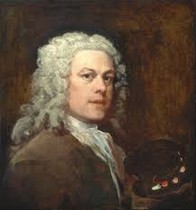 Speaking of his own home, the painter Hogarth (1697-1764), an artist full of strength and social awareness, once defined it as his “little country box on the bank of the Thames”. The building, which is located on the corner between what is now Hogarth Lane and Burlington Lane, is in fact lacking in any type of architectural asset. It sits far back behind the garden walls and cannot be seen from the street. Hogarth used to share the place with his wife, his sister, and his mother-in-law. On the walls, there is a remarkable collection of his engravings. Amongst them, one can make out A Rake’s Progress and Marriage-à-la-mode.
Speaking of his own home, the painter Hogarth (1697-1764), an artist full of strength and social awareness, once defined it as his “little country box on the bank of the Thames”. The building, which is located on the corner between what is now Hogarth Lane and Burlington Lane, is in fact lacking in any type of architectural asset. It sits far back behind the garden walls and cannot be seen from the street. Hogarth used to share the place with his wife, his sister, and his mother-in-law. On the walls, there is a remarkable collection of his engravings. Amongst them, one can make out A Rake’s Progress and Marriage-à-la-mode.The mulberry tree was personally planted by the artist himself, and continues to produce its sweet fruit every summer. Hogarth’s tomb is in the small cemetery of the nearby church of St Nicholas, which we shall speak of in the following chapter.
ST NICHOLAS, THE CHURCH OF FISHERMEN
THE VICARAGE
CHISWICK MALL
UNDERGROUND: STAMFORD BROOK
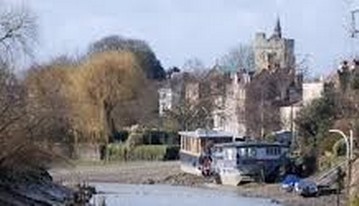 St Nicholas is the saint who is said to protect sailors and fishermen, and it was common practice to dedicate a church to him. This is why in sea areas, where parishioners would survive off fishing, many churches are dedicated to this saint. The church of St Nicholas stands in Church Street, near a docking area for a ferry which used to cross the river. It is believed that this was once a pagan temple, and that in the Seventeenth Century, in the days of the bishop of London known as Mellitus, the building was transformed into a church. A document from 1795 describes it as “having beautiful walnut beams beneath a sloping roof”. The original roof was completely covered by a new one, and thus ruined. In 1884, the church was rebuilt following the design conceived by a man of the cloth. The mortar which keeps the walling together is red, as it has been mixed with the ground up bricks of the old church.
St Nicholas is the saint who is said to protect sailors and fishermen, and it was common practice to dedicate a church to him. This is why in sea areas, where parishioners would survive off fishing, many churches are dedicated to this saint. The church of St Nicholas stands in Church Street, near a docking area for a ferry which used to cross the river. It is believed that this was once a pagan temple, and that in the Seventeenth Century, in the days of the bishop of London known as Mellitus, the building was transformed into a church. A document from 1795 describes it as “having beautiful walnut beams beneath a sloping roof”. The original roof was completely covered by a new one, and thus ruined. In 1884, the church was rebuilt following the design conceived by a man of the cloth. The mortar which keeps the walling together is red, as it has been mixed with the ground up bricks of the old church.From Chiswick Hall, where the church stands, the street follows the river bight towards Hammersmith Bridge, and allows one to take a delightful walk along one of the most beautiful areas of the Thames. The houses and the greenery weave in and out of view, the pubs, with their beckoningly attractive exteriors, and the gardens take turns to be admired. It is blissful to sit back and contemplate the river and the small islet which sits in the middle, known as Chiswick Eyot.
WALPOLE PALACE
CHISWICK MALL
UNDERGROUND: STAMFORD BROOK
 Many different illustrious characters have lived in this charming villa in Twickenham. One of these is Barbara Villiers, countess of Castlemaine and lover of Charles II. She died in 1709. Today the house is known as Walpole House due to the fact that in 1747 the writer Horace Walpole, son of Robert, First Minister of England, chose to rent it for a time. At that time, the villa was known as Strawberry Hill, and two years later it went on to become his property. As well as being the author of the famous Gothic novel The Castle of Otranto, Walpole, along with his poet friend Thomas Gray, was one of the main protagonists in 1739 of the Grand Tour of Italy and France, where he wrote his brilliant epistolary which had both a political/historical and artistic/literary character.
Many different illustrious characters have lived in this charming villa in Twickenham. One of these is Barbara Villiers, countess of Castlemaine and lover of Charles II. She died in 1709. Today the house is known as Walpole House due to the fact that in 1747 the writer Horace Walpole, son of Robert, First Minister of England, chose to rent it for a time. At that time, the villa was known as Strawberry Hill, and two years later it went on to become his property. As well as being the author of the famous Gothic novel The Castle of Otranto, Walpole, along with his poet friend Thomas Gray, was one of the main protagonists in 1739 of the Grand Tour of Italy and France, where he wrote his brilliant epistolary which had both a political/historical and artistic/literary character.After moving into this house, he dedicated the following forty years of his life to making changes to it, and ended up transforming it into a castle that became famous throughout Europe. Among the most beautiful rooms were the library and the bedroom, called the Holbein Room because of the fact that the artist in question had painted some of the paintings hanging on the walls. The Gallery, the Round Tower, and the Beauclerk Tower were instead full of collector's items, such as miniatures and glazes. The bas-reliefs and the portraits of famous people, which were also gathered in the churches, were hung up all over the place: on the walls, on the balustrades, and on the loggias...
The shape of the chimney was inspired by that of the tomb belonging to the Arch Duke Warham, in the Cathedral of Canterbury, whereas the windscreen was inspired by the figures of the choir in the Rouen Cathedral. The chairs and tables dating back to the Seventeenth Century came from the Indies. In the underground areas there was a printing works facility, where Walpole had even printed a guide to the villa, as he had seen others do in France.
The houses near Walpole House are elegant Eighteenth-Century buildings with splendid gardens, some of which are open to the public on Sundays in the summertime.
STRAND-ON-THE-GREEN
54 THAMES ROAD
UNDERGROUND: KEW BRIDGE
This is the name which indicates the tract of the Thames which lies directly to the East of the Kew Bridge. In the Nineteenth Century it was an area of great importance, which witnessed the birth of breweries, dry docks, quays, and barge construction activities... In 1860 one of the greatest laundries in London was opened; its activity lasted a century, and its brick facade is still visible on the left of the Café Rouge.
When the traffic on Grand Junction Canal was redirected towards Brentford and the royal family moved to Windsor, the area lost some of its importance. Amongst the prettier houses to be found in this street is that of Johann Zoffany, at number 65.
The German portrait artist lived here from 1780 to 1810, and was an artist of exceptional technical skill, famous for painting groups of people in their own environment, and portraying famous actors, such as David Garrick, during rehearsal. In 1772, Zoffany came to Italy and painted the Tribuna of the Uffizi for the royal family. One can see a group of experts as they admire the paintings and sculptures of the gallery. It also seems to be the case that the painter modelled the faces of the disciples of the Last Supper, which is now found in the church of St Paul of Brentford, basing them on the faces of some fishermen in Chiswick. The street running through the Islington neighbourhood, which is dedicated to him, is the last in the map index of London.
On the bank, there are some small Nineteenth-century cottages, a row of small houses, and some almshouses from the Eighteenth Century. The latter have their entrances on the first floor at the top of a staircase, so as to avoid the problem of high water. Precisely in front of Strand-on-the-Green lies Oliver's Island. It is said that it gets its name from the fact that Cromwell used it to hide during the civil war, and so that he could hold war room meetings at the nearby pub called Bull's Head. In the Nineteenth Century, the City of London navigation company constructed buildings here, and would dock the barges used for toll collection. During a series of excavations conducted on the riverbed, some skulls and terracotta items were discovered, dating back to the period of Ancient Rome.
THE KEW BRIDGE STEAM MUSEUM
KEW BRIDGE ROAD
UNDERGROUND: KEW BRIDGE
 Kew Bridge, which is covered in a specific section of this book, has an elegant profile and in 1869, when it was built, it passed between the pubs known as City Barge and Bull’s Head.
Kew Bridge, which is covered in a specific section of this book, has an elegant profile and in 1869, when it was built, it passed between the pubs known as City Barge and Bull’s Head.In the building at the corner of Kew Bridge Road with Green Dragon Lane, where there once stood a big pumping station, there is a museum which hosts five steam engines built between 1820 and 1871. Until 1944, they provided water to the west of London. When electric pumps started appearing, it was decided that the station's machinery be preserved, seeing as some of the specimens are quite monumental. The engines are of the 90-inch and 100-inch variety and rest on large bases, created with a single pour of cement. The building also has a beautiful tower, the Standpipe Tower, and it was built later on around them.
The tower was erected in 1867, following the design of the engineer Alexander Fraser, and was inspired by the architecture of an Italian bell tower. It contains some enormous vertical water tubing which used to be pumped through five huge steel pipelines which were protected from freezing over by red bricks built all around them. It is believed that the slits in the brick wall were used for lighting small fires in order to heat the pipes when the temperature reached below zero. At times, in the weekends, the machines are started up and a visit here becomes much more interesting.
THE MUSICAL MUSEUM
399 HIGH STREET
UNDERGROUND: BRENTFORD
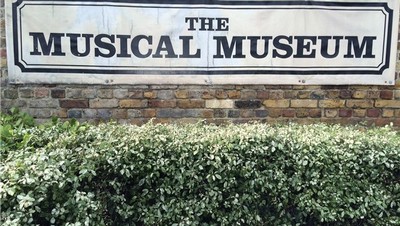 Nowadays, recorded music keeps us company wherever we go, not only at home, but also in the car, in supermarkets, and even in lifts. However, a century ago, this was not the case. At the time, the sonic context was quite a different affair altogether, and the only way to listen to recorded music was to do so through wind-up musical boxes, also known as carillons à musique, or automatic pianos.
Nowadays, recorded music keeps us company wherever we go, not only at home, but also in the car, in supermarkets, and even in lifts. However, a century ago, this was not the case. At the time, the sonic context was quite a different affair altogether, and the only way to listen to recorded music was to do so through wind-up musical boxes, also known as carillons à musique, or automatic pianos.At first, this Musical Museum was hosted in the church of St George. The magnificent collection was created by Frank Holland in the Fifties when electricity and the birth of newer technology for listening to music had condemned these instruments to death. Until the 2000s, they were rather neglected; after that, the administration introduced a building to keep them in, and today the three floors of the museum contain hundreds of musical instruments, both automatic and wind operated.
There are Swiss musical boxes, bells made from horns, automatic pianos, violin-playing devices, the amazing orchestrion, and hurdy-gurdy organs installed on small carts. The collection also includes thirty-thousand music rolls used by buskers, who would use them to make bears and monkeys dance. From the tiny musical box to the impressive Wurlitzer, the organ with a thousand timbres which was born for the accompaniment of mute films, the collection embraces an incredible series of items which make for a captivating journey into the history of music, whilst enjoying the sound produced by them all. An entire street has in fact been recreated, with the shops full of musical toys, unusual instruments, all accurately restored. There are also some temporary exhibitions on the theme. It is located on High Street, which is the western extension of the street just next to the Kew bridge. It is quite near the museum.
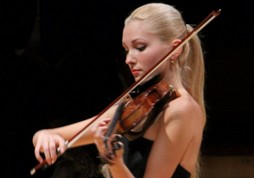 During the weekend one can witness some specialized volunteers who carry out interesting performances with the musical instruments. One can attend a concert comfortably seated in one of the two hundred and thirty seats in the hall. It feels as if one is listening to the music that once accompanied silent films back in those days. One should consult the program, which shows the list of upcoming concerts. Anyone who is interested in doing so, may organize a party in this unusual and charming place.
During the weekend one can witness some specialized volunteers who carry out interesting performances with the musical instruments. One can attend a concert comfortably seated in one of the two hundred and thirty seats in the hall. It feels as if one is listening to the music that once accompanied silent films back in those days. One should consult the program, which shows the list of upcoming concerts. Anyone who is interested in doing so, may organize a party in this unusual and charming place.BOSTON MANOR HOUSE
BOSTON MANOR ROAD
UNDERGROUND: BOSTON MANOR
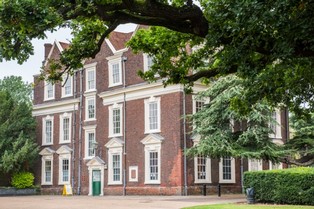 The Boston Manor House was built in 1623 for Lady Mary Reade. In 1924, the Brentford administration purchased and restored it. The rooms on the first floor of this Jacobean building built with red bricks, decorated with ashlars, are all open to the public. The great hall has a beautiful ceiling upon which the initials M.R. have been reproduced, which testify the ancient origin of the house. The figures that can be seen holding some partly unwound paper scrolls, inserted between the brackets of the elaborate plasterwork, represent the Senses, War, Peace, Abundance, Faith, Hope, and Charity.
The Boston Manor House was built in 1623 for Lady Mary Reade. In 1924, the Brentford administration purchased and restored it. The rooms on the first floor of this Jacobean building built with red bricks, decorated with ashlars, are all open to the public. The great hall has a beautiful ceiling upon which the initials M.R. have been reproduced, which testify the ancient origin of the house. The figures that can be seen holding some partly unwound paper scrolls, inserted between the brackets of the elaborate plasterwork, represent the Senses, War, Peace, Abundance, Faith, Hope, and Charity.Their medieval immobility is in contrast to the exuberant decorations of everything else around. Above the fireplace, there is a painting by Abraham De Buyn which represents the sacrifice of Isaac. The grounds surrounding the house, with their magnificent cedar trees, which were probably planted by one of the first landlords, have now become a public park. There is also an ornamental lake.
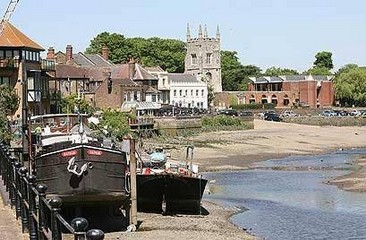 The small suburb of Isleworth to the west of the Thames and beside Richmond is of Saxon origin. The excavation works have also brought to light items that indicate the presence of an ancient Roman settlement near what is now Syon Park.
The small suburb of Isleworth to the west of the Thames and beside Richmond is of Saxon origin. The excavation works have also brought to light items that indicate the presence of an ancient Roman settlement near what is now Syon Park.In the Eighteenth Century, Isleworth was rich with orchards and many fruit and vegetable farms. In Lower Square and in Church Street, there are still many buildings dating back to the Eighteenth and Nineteenth Century, a time when royalty, nobility, and those belonging to the highest ranks of the church would come here to have houses built for them. Old Isleworth once had a larger territory than it does at present, with many Georgian-style houses overlooking the Thames, in Church Street. On the long islet in the middle of the river, known as Isleworth Ait, there were once many willows, used for building baskets. Today there is a barge docked here, which goes by the name of Cathja and is thirty-eight metres long. Since 1996, it has been used by a charitable organization to help the mentally challenged. Onboard, stands a sculpture of a heron carried out by Martin Cotts.
In old Isleworth, in Mill Plat Avenue (literally meaning "a piece of land belonging to the mill"), stand six small bungalows built in dark bricks, immersed in the green. These were once almshouses, and are still kept well to date, with a plaque on each door bearing a warning in case of a flood.
The rivers that act as boundaries to Isleworth are the Crane and the Brent, and along the latter’s banks many factories and offices have sprung up. The affluent Duke of Northumberland's River passes directly through it.
In the past, ferries used to dock here. There was one known as "the church ferry", which used to take passengers to Kew and Richmond. These boats still existed in 1947, fifty years after the construction of the pedestrian bridge.
The north-western extremity, which borders on Osterley, is known as Spring Grove, due to the abundance of natural water sources. In 1779, Joseph banks, the greatest English botanist, purchased a house with some land just north of London Road. There, he created a park which was a masterpiece, with exotic plants brought all the way from Australia and the Southern Seas, were he had travelled alongside Captain Cook.
SYON HOUSE
SYON PARK
UNDERGROUND: SYON LANE
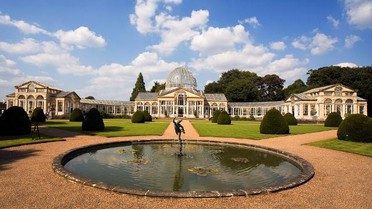 Syon House was once a medieval abbey. In 1542, when Henry VIII disbanded the monasteries, the Bridgettine nuns, who lived here, were forced to move out. The building was then bought by the rich merchant Thomas Gresham. In 1632 an arcade was added, following the design by Inigo Jones, and it took on a square structure, with towers on all four corners. Halfway through the XVIII Century, the building passed over to the hands of the Duke of Northumberland, who employed the architect Robert Adam to transform it into a masterpiece.
Syon House was once a medieval abbey. In 1542, when Henry VIII disbanded the monasteries, the Bridgettine nuns, who lived here, were forced to move out. The building was then bought by the rich merchant Thomas Gresham. In 1632 an arcade was added, following the design by Inigo Jones, and it took on a square structure, with towers on all four corners. Halfway through the XVIII Century, the building passed over to the hands of the Duke of Northumberland, who employed the architect Robert Adam to transform it into a masterpiece. The rooms give an idea of what the life of an aristocrat was like halfway through the Eighteenth Century. The entrance, with its black and white marble flooring and plasterwork, is decorated by a pair of statues of the Apollo of the Belvedere and a pair of statues of the Dying Gaul, the original copy of which is located in Rome.
The halls on the first floor have blue, gold and carmine walls. In the niches of the dining room, there are some statues in the classical style, and above the chimney, a bas-relief which represents the Three Charites, also known as Graces. The red sitting room has walls covered in tapestry made from Spitafields silk, and there is a carpet designed by Adam himself. The Great Gallery, which matches the house in length, which Adam had decided to have painted in pale green and mauve, was supposed to offer "variety and entertainment to the ladies who were to make use of it". The painting of the sixty-two pillars was assigned to Michelangelo Pergolesi, who was paid three guineas for each one. The changing room, named the Etruscan Dressing Room, was partly inspired by Herculaneum.
William Turner, the father of English botany, was assigned to the creation of the gardens. Amongst the varieties that he had planted were mulberries, which still bloom every year, and which were the first specimens to be imported. In 1770, Lancelot Brown created a lake, which snakes through the field and the wood before turning around a Dorian pillar upon which there is a statue of the goddess Flora. In 1827, in the garden a great veranda was built in glass and Bath stone, designed by Fowler, with internal pillars in cast iron and a dome at the centre. Today it hosts an aviary on one side, and a vast aquarium on the other. On the arch that looms above the magnificent golden gate, there is a Percy Lion
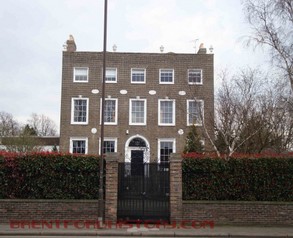 Syon Lodge - This home dating back to the Eighteenth Century and in the Georgian style, was originally a dowry. The lower part once hosted the stables, but was later restored and transformed into a living area. At the back of the house there is a loggia which was acquired directly from Venice. On the inside, it is covered in panels dating back to the Seventeenth Century which come from a monastery and there is an enormous stone fireplace which is extremely beautiful.
Syon Lodge - This home dating back to the Eighteenth Century and in the Georgian style, was originally a dowry. The lower part once hosted the stables, but was later restored and transformed into a living area. At the back of the house there is a loggia which was acquired directly from Venice. On the inside, it is covered in panels dating back to the Seventeenth Century which come from a monastery and there is an enormous stone fireplace which is extremely beautiful. THE GLOBAL SUNDIAL AT ALL SAINTS
CHURCH STREET
TUNDERGROUND: ISLEWORTH
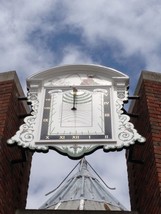 The church of All Saints occupies a splendid position. From the facade, one can admire a very unusual sundial. It is commemorated to Susannah Lawes, who died in 1707. When the weather is sunny, it simultaneously shows the time in Isleworth, Jamaica, where the woman actually lived, as well as Jerusalem and Moscow.
The church of All Saints occupies a splendid position. From the facade, one can admire a very unusual sundial. It is commemorated to Susannah Lawes, who died in 1707. When the weather is sunny, it simultaneously shows the time in Isleworth, Jamaica, where the woman actually lived, as well as Jerusalem and Moscow.The original church, which dates back to the Fourteenth Century, used to overlook the Thames. At the start of the Eighteenth Century, a new one was built following Wren's previous design; however it was destroyed in 1943 by two students who set fire to it. The current church was reconstructed in 1970, and preserves some of the parts constructed in previous epochs. The walls of the gigantic tower form an enclosed area where water coming from a fountain ebbs, symbolizing the waters of baptism. Four overturned pyramids, supported by solid pillars, bear the weight of the ceiling. On the side facing the river, we can see the Joshua chapel with its rounded shape. Its name refers to that of a child who died at the age of two.
OSTERLEY MANOR
JERSEY ROAD
UNDERGROUND: OSTERLEY
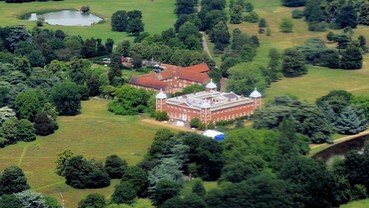 Osterley House is a building built in red bricks with turrets at the corners, which encloses a courtyard. In 1761 Robert Adam worked here, after returning from Italy. He transformed the previous building, by adapting it to the needs of the Child family. In 1949, the Duke of Jersey handed it over to the National Trust.
Osterley House is a building built in red bricks with turrets at the corners, which encloses a courtyard. In 1761 Robert Adam worked here, after returning from Italy. He transformed the previous building, by adapting it to the needs of the Child family. In 1949, the Duke of Jersey handed it over to the National Trust.In the dining room, where all that remains are the chairs lined up against the walls, there are paintings by Zucchi both at the extremities of the hall and also above the doors. Above the fireplace there is a landscape painted by Cipriani.
Some time ago, at the top of the great staircase, there used to be a painting by Rubens, Apotheosis of a Hero, which had been removed by the last owner and was destroyed in a fire. The tapestries in the antechamber of the bedroom for guests were drawn in the Gobelins factory in Paris and represent the gods of the Olympus. The decorations in the changing room are of Greek inspiration. Walpole did not care for them much and was known for saying that they reminded him of Wedgwood ceramics.
The park hosts a farm with its cultivated land and bovine breeding. It is a peaceful refuge, far from the hectic life of the city and perfect for a picnic, a walk around the lake, or a ride on a bike.
The inside area can be visited through some audio-visual guides. A film is regularly projected in the stables, recreating the everyday life of a time gone by to great effect.
 The area of Finsbury is situated directly to the north of the City, and is extremely interesting, with pretty squares, such as Myddleton Square and streets flanked by houses built in the Georgian style, such as Amwell Street. In the Eighteenth Century it was an area almost completely made up of parks, where people would come for a walk. Later on, the Blitz destroyed most of it, and due to the high demand for houses in the post-war period, some parts of the area have been densely built up and populated. However there are still many gardens, full of roses and broom, as well as a number of parks.
The area of Finsbury is situated directly to the north of the City, and is extremely interesting, with pretty squares, such as Myddleton Square and streets flanked by houses built in the Georgian style, such as Amwell Street. In the Eighteenth Century it was an area almost completely made up of parks, where people would come for a walk. Later on, the Blitz destroyed most of it, and due to the high demand for houses in the post-war period, some parts of the area have been densely built up and populated. However there are still many gardens, full of roses and broom, as well as a number of parks.The greatest of these is Finsbury Park, created in 1857, with its numerous boulevards of centuries-old trees and an arboretum of very unusual ones. Here we find the beautiful McKenzie garden and also various sports facilities. The architect Berthold Lubetkin, originally from Tbilisi in Georgia, who was known for saying "Nothing is too good for ordinary people", planned a wellness centre for this spot. Amid the trees stands the low and lengthy structure of St John Street, covered with grey and black tiles.
Here the architect not only designed the building to be functional for those using it, but also put his principle into practice, making it so that there might not be anything better for common people. Unfortunately today it risks being shut down, and the architect's daughter has launched appeals to avoid her father's hard work from being disassembled.
One of the buildings of greater interest for its size, if not for its value alone, is Finsbury Tower, and incredibly tall ultra-modern tower, which is in fact a parking lot.
FINSBURY PARK
UNDERGROUND: FINSBURY PARK
Finsbury Park opened on August 7th, 1869, and was the first to be approved by the Parliament as a public park. It was recovered from a vast land property largely covered by a wood, with a manor at its centre which is still there today. The park is a mix of open spaces, classic Italian gardens, and boulevards flanked by centuries-old trees. There is also an arboretum, with a selection of rare plants, cultivated for study purposes. At the top of the small hillock, there is a lake which has been created with the water of the New River, which can be reached by boat.
After a walk along the lake's edge, one can visit the McKenzie gardens, which are full of blooming flowerbeds. Wild bird hunting used to take place on the lake's banks, and there was a field for practising archery and an area for cockfighting.
Finsbury Park hosts a number of important sports facilities, a café and a venue for art exhibitions. During the summer, a great number of open-air concerts are held here, and it is very pleasant to take part.
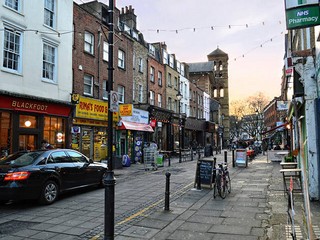 The name comes from the Clerks Well in Farringdon Lane, the well that is now located at number 14-16 in the same street. This was the meeting place for the religious company and the parish administrators, who would gather here to pray and recite the so-called mystery plays. Then, in 1144, Jordan de Briset, benefactor of the Order of the Knights of the Hospital of Saint John of Jerusalem, gave them five acres of land near the well, so that they could build a church and a monastery, destined for hosting pilgrims heading for the Sacred Land.
The name comes from the Clerks Well in Farringdon Lane, the well that is now located at number 14-16 in the same street. This was the meeting place for the religious company and the parish administrators, who would gather here to pray and recite the so-called mystery plays. Then, in 1144, Jordan de Briset, benefactor of the Order of the Knights of the Hospital of Saint John of Jerusalem, gave them five acres of land near the well, so that they could build a church and a monastery, destined for hosting pilgrims heading for the Sacred Land.The well is still visible and gave the whole district its name. The place was forgotten for a long time, before being rediscovered in 1924. The oldest part of the well room is built in stone, whereas the more recent part is made of Tudor bricks. It is located underground and can be seen also from the outside, through the windows which have been created for this precise purpose.
For a century, starting in 1850, Clerkenwell was an area of Italian immigration. Because of this, it was called Little Italy.
SMITHFIELD MARKET
CHARTERHOUSE STREET
UNDERGROUND: FARRINGDON
 Slaughterhouses have always cast a spell of fascination on writers, if for example one recalls the descriptions by Céline or Simone de Beauvoir of that of Detroit. In Smithfield Market there is an echo of Dickens, or perhaps one of Hogarth's paintings.
Slaughterhouses have always cast a spell of fascination on writers, if for example one recalls the descriptions by Céline or Simone de Beauvoir of that of Detroit. In Smithfield Market there is an echo of Dickens, or perhaps one of Hogarth's paintings.At one time, herds were lined up within and guttural cries would issue forth, along fences built with wooden bars. Today one can still observe butchers transporting sides of beef or other meat on their shoulders, as the market is an important point of reference for the world of London catering and restaurants.
At five in the morning, one can already order a steak or pork chop in one of the nearby pubs.
In the past, it would happen that every now and then everything would be cleared out and cleaned up in a hurry, as a post needed to be erected for burning the odd heretic...
CHURCH OF ST JOHN
ST JOHN'S SQUARE
UNDERGROUND: FARRINGDON
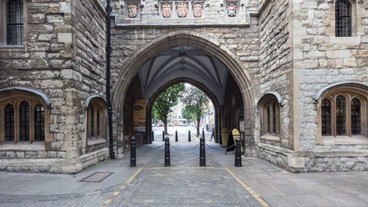 The original church had a circular layout, as homage to that of the Holy Sepulchre of Jerusalem. The sign of the wall curvature is still visible on the cobblestones in the square. Towards the middle of the Nineteenth Century, the order of St John had begun to take care of the nursing care and ambulance service, and had ensured itself possession of the only surviving part of the hospital building, the gatehouse, which was the entrance to the south of the monastery enclosure. In 1931, the Order also took the church, which was no longer needed for the purposes of the parish.
The original church had a circular layout, as homage to that of the Holy Sepulchre of Jerusalem. The sign of the wall curvature is still visible on the cobblestones in the square. Towards the middle of the Nineteenth Century, the order of St John had begun to take care of the nursing care and ambulance service, and had ensured itself possession of the only surviving part of the hospital building, the gatehouse, which was the entrance to the south of the monastery enclosure. In 1931, the Order also took the church, which was no longer needed for the purposes of the parish.The crypt was one of the most beautiful examples of architecture during the Twelfth Century. On the ceiling, one can see the veining in the stone surface and along the northern wall lies the tomb of Don Juan Ruiz of Vergara, who died in 1575 and was brought here from Valladolid in 1915. Above the tomb, there is a statue of his entire figure, his attractive face appearing at peace in death, his hand on his sword, and a page boy stooping at his feet. Nearby, there is an effigy of the Pryor William Westall, who died of a broken heart when the Order was disbanded.
THE CHURCH OF ST JAMES
CLERKENWELL GREEN
UNDERGROUND: FARRINGDON
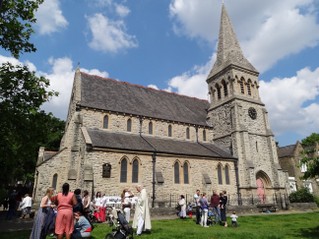 The church is in a rearward position, in one of the more elegant corners of London. It was built at the end of the Eighteenth Century. At the end of the brick facade there is a stone tower, with another steeple in the shape of an obelisk. This is a typical rural church with a rounded western side. Inside the gallery there is a modern organ in warm colours, situated in the place of the original one dating back to 1792.
The church is in a rearward position, in one of the more elegant corners of London. It was built at the end of the Eighteenth Century. At the end of the brick facade there is a stone tower, with another steeple in the shape of an obelisk. This is a typical rural church with a rounded western side. Inside the gallery there is a modern organ in warm colours, situated in the place of the original one dating back to 1792.The square upon which the church stands, Clerkenwell Green, is very lively, thanks to the numerous pubs and restaurants.
KARL MARX'S LIBRARY
37A CLERKENWELL GREEN
UNDERGROUND: FARRINGDON
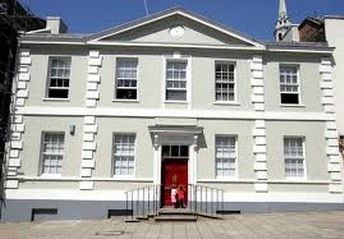 The library is hosted within an attractive building dating back to the Eighteenth Century, known as Marx House, which faces the pedestrian area of Clerkenwell Green and has a pretty red door. Containing one hundred and fifty thousand volumes of left-wing literature, it represents a container of the social history of the city, ranging from the farmers revolts in 1381 to rebellions against taxes, all the way up to the present day. Throughout the years, the building has hosted a school for poor children, a few laboratories, a pub, and a café for workers. It was also the headquarters for a radical circle, supported by John Stuart Mill and attended by Eleanor Marx, and the typography Twentieth Century Press, funded by William Morris and active for many years. The typography was also used by Lenin, who during his years of exile, came here to publish the Russian social democratic newspaper Iskra. Here one can also visit his study, which is almost unchanged, with blue wardrobes, books bound in leather, and a Braille edition of The Manifest of the Communist Party. Many of the first editions of the works in English by Marx and Engels were published here.
The library is hosted within an attractive building dating back to the Eighteenth Century, known as Marx House, which faces the pedestrian area of Clerkenwell Green and has a pretty red door. Containing one hundred and fifty thousand volumes of left-wing literature, it represents a container of the social history of the city, ranging from the farmers revolts in 1381 to rebellions against taxes, all the way up to the present day. Throughout the years, the building has hosted a school for poor children, a few laboratories, a pub, and a café for workers. It was also the headquarters for a radical circle, supported by John Stuart Mill and attended by Eleanor Marx, and the typography Twentieth Century Press, funded by William Morris and active for many years. The typography was also used by Lenin, who during his years of exile, came here to publish the Russian social democratic newspaper Iskra. Here one can also visit his study, which is almost unchanged, with blue wardrobes, books bound in leather, and a Braille edition of The Manifest of the Communist Party. Many of the first editions of the works in English by Marx and Engels were published here.The great fresco of Jack Hastings from 1935 goes by the title Heroic worker in the act of overturning the economic chaos of the present. Also Marx, Engels, and Lenin are portrayed with gigantic proportions. The library continues its activity of lending books that even today continue to give the reader pause to reflect.
THE CLERKENWELL CHARTERHOUSE
CHARTERHOUSE SQUARE
UNDERGROUND: FARRINGDON
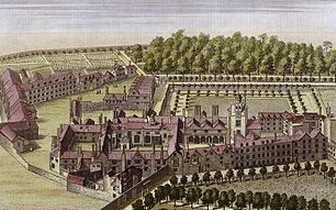 The history of Charterhouse begins in 1348 with the plague. The cemeteries of London were overflowing with corpses, thus Walter Manny rented thirteen acres of land from St Bartholomew Hospital in order to use it as a cemetery. He also had a chapel built, so that one might celebrate mass for the dead. In 1371 a Carthusian Monastery was founded with a large cloister, surrounded by twenty-four cells. Each monk had his own, where he would pray, eat, and sleep. Thomas More lived here for four years, undecided as to whether to become a monk. The following owners were the court Chancellor, who had the church demolished in order to build an auditorium/lecture hall/great hall, and the Duke of Norfolk, executed for having taken part in the Ridolfi plot, which had aimed to assassinate Elizabeth I and replace her on the throne with Mary of Scotland. In 1611, Thomas Sutton had a hospital built, as well as some almshouses and a school. The compound was restored after the bombing in 1941, which led to the underground discovery of the fragments of a medieval monastery.
The history of Charterhouse begins in 1348 with the plague. The cemeteries of London were overflowing with corpses, thus Walter Manny rented thirteen acres of land from St Bartholomew Hospital in order to use it as a cemetery. He also had a chapel built, so that one might celebrate mass for the dead. In 1371 a Carthusian Monastery was founded with a large cloister, surrounded by twenty-four cells. Each monk had his own, where he would pray, eat, and sleep. Thomas More lived here for four years, undecided as to whether to become a monk. The following owners were the court Chancellor, who had the church demolished in order to build an auditorium/lecture hall/great hall, and the Duke of Norfolk, executed for having taken part in the Ridolfi plot, which had aimed to assassinate Elizabeth I and replace her on the throne with Mary of Scotland. In 1611, Thomas Sutton had a hospital built, as well as some almshouses and a school. The compound was restored after the bombing in 1941, which led to the underground discovery of the fragments of a medieval monastery.Two floors of living quarters were added to the medieval entrance arch in the Nineteenth Century. Today the Charterhouse hosts around forty pensioners and most of it is not open to the public. However, it is most interesting to visit the medieval courtyard, which is akin to that of a college such as Oxford or Cambridge.
BUNHILL FIELDS
CITY ROAD
UUNDERGROUND: OLD STREET
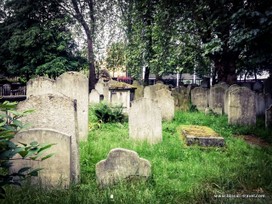 The area of Bunhill, which is a mangling of the name Bonehill, was a prehistoric area of land for burial, which remained open until 1852, as a cemetery for dissenters of the Anglican religion. Some of the famous people buried in this lush green oasis are: Daniel Defoe, author of Robinson Crusoe,and William Blake, visionary poet and painter, with his wife Catherine Sophia. Directly in front is the Wesley chapel, near the house of the great preacher.
The area of Bunhill, which is a mangling of the name Bonehill, was a prehistoric area of land for burial, which remained open until 1852, as a cemetery for dissenters of the Anglican religion. Some of the famous people buried in this lush green oasis are: Daniel Defoe, author of Robinson Crusoe,and William Blake, visionary poet and painter, with his wife Catherine Sophia. Directly in front is the Wesley chapel, near the house of the great preacher.Today Bunhill Fields is a beautiful park enclosed by a grating with large trees, where one can go for a walk, sit on a comfortable bench, and read or rest.
 The first reference to Islington appears on a map from 1590. At the time, along High Road there were at least a dozen inns, including the famous Angel which gave the surrounding area its name. The Peacock Inn, which since 1564 has stood at number 11, already appears in a book where it is described as the inn where a boy called Tom usually stays before going to Rugby. There are also ponds, one large one and other smaller ones, where Henry VII used to go duck hunting. Walter Raleigh once lived on Upper Street, where he also owned a bar. To the east of High Street, in the labyrinth of old streets, a congregation of small antique shops has developed in time. On Fridays and Saturdays there is a market, which is the worthy successor of the Caledonian Market.
The first reference to Islington appears on a map from 1590. At the time, along High Road there were at least a dozen inns, including the famous Angel which gave the surrounding area its name. The Peacock Inn, which since 1564 has stood at number 11, already appears in a book where it is described as the inn where a boy called Tom usually stays before going to Rugby. There are also ponds, one large one and other smaller ones, where Henry VII used to go duck hunting. Walter Raleigh once lived on Upper Street, where he also owned a bar. To the east of High Street, in the labyrinth of old streets, a congregation of small antique shops has developed in time. On Fridays and Saturdays there is a market, which is the worthy successor of the Caledonian Market.NEW CALEDONIAN MARKET
MARKET ROAD
UNDERGROUND: CALEDONIAN ROAD
The iron grating is painted black, with the support posts which bring to mind ancient Greek pillars. Where today there are only some holes to be seen, there was once probably a representation of the heads of animals, a reference to the market activity of the past. On the northern side there is a beautiful clock tower, its style imitating the Italian baroque. It once stood at the centre of the Metropolitan Cattle Market, so it was enough to raise one's gaze to know what time it was. The livestock market was huge. It could host up to thirty-five thousand sheep, six thousand five hundred cows, one thousand five hundred calves, and one thousand pigs.
Later on, the Caledonian market diversified and became the greatest market in the world. It closed in 1939. Today, the New Caledonian Market, also known as Bermondsey Market, is located at Bermondsey Square, on Tower Bridge Road, Southwark.
ITALIAN FUTURISTS IN THE ESTORICK GALLERY
39, CANONBURY SQUARE
UNDERGROUND: HIGHBURY & ISLINGTON
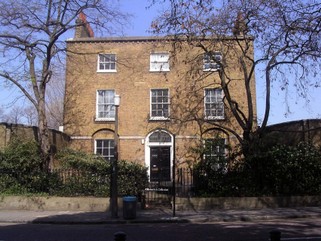 Eric Estorick was a sociologist and writer born in the United States in 1913, who started collecting works of art when he moved to England. The interesting gallery created by him is found in the house in Canonbury Square and has been there since the Nineteenth Century. It hosts the only collection of Italian Futurist painters to be found in the whole of Great Britain, with paintings by Sironi, Boccioni, Carrà, Severini, and Russolo. It also includes a section of figurative art from the period from 1890 to 1950, with works by Modigliani, Marino Marini, Morandi, and De Chirico. There are also some illustrations by Picasso and Braque.
Eric Estorick was a sociologist and writer born in the United States in 1913, who started collecting works of art when he moved to England. The interesting gallery created by him is found in the house in Canonbury Square and has been there since the Nineteenth Century. It hosts the only collection of Italian Futurist painters to be found in the whole of Great Britain, with paintings by Sironi, Boccioni, Carrà, Severini, and Russolo. It also includes a section of figurative art from the period from 1890 to 1950, with works by Modigliani, Marino Marini, Morandi, and De Chirico. There are also some illustrations by Picasso and Braque.Estorick also created the Grosvenor Gallery in a Georgian villa, which still now hosts events and temporary exhibitions.
There is also a rich art library and a shop. In the warm season, the café in the garden is a perfect place for lunch out in the open air. Alternatively, or as a fitting conclusion to a pleasant evening, one can go to the Old Queen's Head, at 44, Essex Road. On the upper floor, there is live music.



